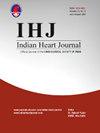开创性的心电图观察:"等电位水平 ST 段与尖锐 ST-T 角 "是急性冠状动脉综合征的新征兆。
IF 1.8
Q3 CARDIAC & CARDIOVASCULAR SYSTEMS
引用次数: 0
摘要
连续的疑似急性冠状动脉综合征(ACS)病例被分为三组:第 1 组(ST-压低)、第 2 组(T-倒置)和第 3 组(其余病例)。第 3 组又分为等电位水平 ST 段与尖锐 ST-T 角(IHST)阳性组和 IHST 阴性组。他们接受了连续的高敏肌钙蛋白-I检测。ACS发生率为77.96%,第1、2和3组(IHST阳性、IHST阴性)患者的ACS发生率分别为33.02%、15.96%和(15.04%、35.96%)。在检测 ACS 方面,IHST 的灵敏度高于 T-倒置,特异性高于 ST-压低。IHST征的存在可额外检测出15.04%的ACS。在第 3 组(p = 0.008)和所有 ACS 病例(p = 0.048)中,IHST 的存在具有显著性。本文章由计算机程序翻译,如有差异,请以英文原文为准。
A groundbreaking electrocardiographic observation: “Isoelectric horizontal ST-segment with sharp ST-T angle” a novel sign for acute coronary syndrome
Consecutive suspected acute coronary syndrome (ACS) cases were categorized into three groups: Group-1 (ST-depression), Group-2 (T-inversion), and Group-3 (remaining cases). Group-3 was subclassified into isoelectric horizontal ST-segment with sharp ST-T-angle (IHST) positive and IHST negative groups. They underwent serial high-sensitive Troponin-I testing. ACS incidence was 77.96 %, with 33.02 %, 15.96 %, and (15.04 %, 35.96 %) of patients in Groups 1, 2, and 3 (IHST positive, IHST negative), respectively. The presence of IHST exhibited higher sensitivity than T-inversion and greater specificity than ST-depression in detecting ACS. The presence of IHST sign additionally detected 15.04 % of ACS. The presence of IHST was significant among group-3 (p = 0.008) as well as the overall ACS cases (p = 0.048).
求助全文
通过发布文献求助,成功后即可免费获取论文全文。
去求助
来源期刊

Indian heart journal
CARDIAC & CARDIOVASCULAR SYSTEMS-
CiteScore
2.60
自引率
6.70%
发文量
82
审稿时长
52 days
期刊介绍:
Indian Heart Journal (IHJ) is the official peer-reviewed open access journal of Cardiological Society of India and accepts articles for publication from across the globe. The journal aims to promote high quality research and serve as a platform for dissemination of scientific information in cardiology with particular focus on South Asia. The journal aims to publish cutting edge research in the field of clinical as well as non-clinical cardiology - including cardiovascular medicine and surgery. Some of the topics covered are Heart Failure, Coronary Artery Disease, Hypertension, Interventional Cardiology, Cardiac Surgery, Valvular Heart Disease, Pulmonary Hypertension and Infective Endocarditis. IHJ open access invites original research articles, research briefs, perspective, case reports, case vignette, cardiovascular images, cardiovascular graphics, research letters, correspondence, reader forum, and interesting photographs, for publication. IHJ open access also publishes theme-based special issues and abstracts of papers presented at the annual conference of the Cardiological Society of India.
 求助内容:
求助内容: 应助结果提醒方式:
应助结果提醒方式:


